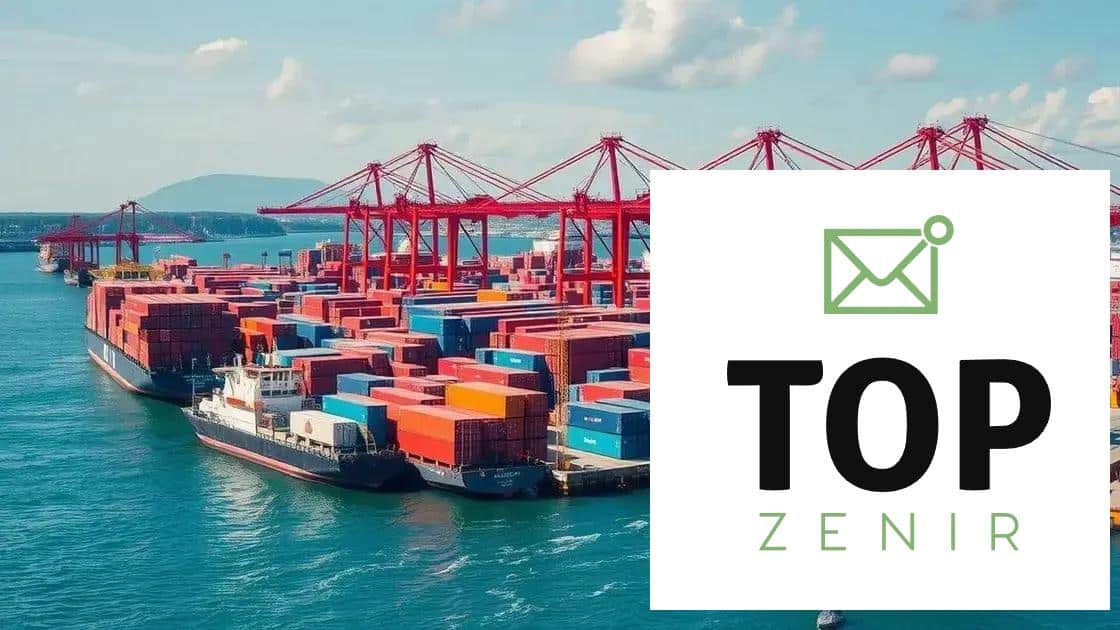Tariff policy reaction under Trump-era rules: A closer look

Tariff policy reactions under Trump-era rules significantly influenced global trade dynamics, leading to both opportunities for domestic industries and challenges in international relationships, impacting prices and supply chains.
Tariff policy reaction under Trump-era rules transformed the landscape of international trade. Curious about its effects on various industries and the economy? Let’s delve into the details.
Understanding tariff policies under Trump
Understanding tariff policies under Trump requires a look at the broader picture of trade. The policies implemented during his administration had significant effects on both local and global economies. This analysis will help clarify how tariffs influenced various sectors.
Key Elements of Trump’s Tariff Policies
Trump’s approach to tariffs focused on protecting American jobs and industries. He believed that imposing tariffs on foreign goods would reduce competition and promote domestic production. This was particularly true for industries like steel and aluminum, which faced increased tariffs.
- Increased tariffs on steel and aluminum imports.
- Utilization of Section 232 for national security arguments.
- Retaliatory measures from trading partners.
- Impact on consumer prices and availability.
The rhetoric around these tariffs was adamant, emphasizing a need for fairness in trade practices. Critics argued that this approach may lead to trade wars and higher prices for consumers. Despite this, Trump maintained that these policies were necessary to revive American manufacturing.
Stakeholder Reactions
Different stakeholders had varying reactions to the changes in tariff policies. Industries that benefitted from tariffs, such as steel manufacturers, supported the measures wholeheartedly. Conversely, those relying on imported materials expressed concern about increased costs.
Farmers, too, felt the impact. While some agricultural products faced tariffs, they also found new markets emerging as trade relationships shifted. This dynamic created a mixed bag of outcomes that illustrated the complexities of the situation.
Furthermore, the global response to these tariffs initiated a series of retaliatory tariffs. Countries like China implemented counter-tariffs affecting numerous American products, deepening trade tensions. Such actions raised questions about the sustainability and long-term effects of these tariff policies.
In light of all this, the long-term implications of Trump’s tariff policies continue to unfold. Some analysts suggest that while short-term benefits were apparent in specific sectors, the broader economic landscape may feel the ramifications for years to come.
Economic impacts of Trump-era tariffs
The economic impacts of Trump-era tariffs have been a point of discussion among economists and industries alike. These tariffs disrupted traditional trade patterns and had both positive and negative effects on the U.S. economy. Understanding these impacts is essential for grasping the overall effect of his administration’s policies.
Benefits of Tariffs
One of the main arguments for imposing tariffs was to protect domestic industries. By increasing the cost of imported goods, these tariffs aimed to encourage consumers to buy American-made products. This would, in theory, boost local manufacturing and job creation.
- Increased sales for domestic manufacturers.
- Job growth in protected industries.
- Potential for investment in local production facilities.
Additionally, some industries, like steel and aluminum production, saw immediate benefits. As demand for domestic products increased, these sectors expanded to meet the new market needs.
Negative Consequences
However, the imposition of tariffs also led to several negative economic consequences. Consumers began to face higher prices for everyday goods due to the increased costs of imports. Trade tensions escalated, leading to retaliatory tariffs from other countries.
- Higher consumer prices on imported goods.
- Increased economic uncertainty for businesses.
- Farmers faced restrictions on exports to certain markets.
Moreover, some sectors that relied on imported materials struggled with increased costs that eating into their profit margins. The farming industry, for example, experienced significant challenges when countries like China imposed retaliatory tariffs on agricultural products, severely impacting farmers’ income.
Overall, while the intent of the tariffs was to safeguard American jobs and industries, the resulting economic landscape showed both gains and losses. Analyzing these mixed outcomes gives insight into how tariffs can influence broader economic trends.
Industry responses to changes in tariffs
Industry responses to changes in tariffs were varied and often quite dramatic. As tariffs were introduced, businesses had to quickly adapt to a new economic reality. Some industries embraced these changes, while others struggled to cope with the pressures that came with them.
Positive Adaptations
Many manufacturers found opportunities amid the turmoil. Domestic companies producing goods like steel and aluminum saw a surge in demand. The tariffs allowed them to compete against cheaper foreign imports more effectively.
- Increased investments in domestic manufacturing.
- Job creation in affected sectors.
- Expansion of production capacity to meet local demand.
For some industries, the tariffs provided a chance to innovate. Companies began exploring new technologies and processes to improve efficiency and reduce costs. This kind of adaptation can lead to long-term benefits for the industry as a whole.
Challenges Faced by Other Industries
Conversely, industries that relied heavily on imported materials felt the negative effects of tariff increases. For example, the construction industry experienced rising costs for essential materials, which could lead to higher prices for consumers.
- Increased costs of building materials.
- Supply chain disruptions due to tariff restrictions.
- Reduced profit margins for businesses reliant on imports.
Additionally, farmers who exported products faced retaliatory tariffs from countries like China. This left them in a challenging position, as they had fewer options for selling their goods internationally. As a result, market instability affected their incomes and overall economic health.
Overall, these responses to tariff changes illustrate the complexity of the economic landscape. While some industries adapted and thrived, others faced unexpected challenges. This dynamic environment continues to evolve as industries react to ongoing shifts in trade policies.
Global trade dynamics during Trump’s presidency

Global trade dynamics during Trump’s presidency were notably affected by his administration’s trade policies. The trade landscape shifted dramatically as the U.S. took a more aggressive stance on tariffs and trade agreements, leading to both changes in relationships with allies and adversaries.
Changes in Trade Agreements
Trump’s administration aimed to renegotiate several existing trade agreements. One of the key achievements was replacing the North American Free Trade Agreement (NAFTA) with the United States-Mexico-Canada Agreement (USMCA). This new agreement sought to provide better terms for American workers and industries.
- USMCA aimed to protect U.S. farmers and manufacturers.
- Stronger labor and environmental standards were introduced.
- Increased access for U.S. dairy products in Canada.
These changes signified a move towards more favorable terms for the United States, reflecting Trump’s focus on prioritizing American interests.
Escalating Trade Tensions
Alongside these agreements, Trump’s presidency also experienced escalating trade tensions, particularly with China. The imposition of tariffs on Chinese goods aimed at addressing trade imbalances but sparked a tit-for-tat trade war. China responded with its own tariffs on U.S. goods, creating uncertainties in several markets.
- Both countries faced economic repercussions from the tariffs.
- Affected sectors included technology, agriculture, and manufacturing.
- Market volatility became a concern for investors and consumers alike.
As the trade war escalated, it became clear that both nations were struggling with the impacts. American farmers were especially hard hit, as they faced challenges exporting their products to China under retaliatory tariffs.
Moreover, these global trade dynamics prompted discussions around supply chains. Companies began reassessing their reliance on specific countries for manufacturing, with some looking to diversify their supply chains to mitigate risks associated with trade tensions.
The shifting trade dynamics during Trump’s presidency highlight the complexity of global economics and the interplay between domestic policies and international relations. As nations navigated these changes, the long-term effects on global trade relationships continue to unfold, showcasing the lasting impact of tariff policies and negotiations.
Future implications of tariff policies
The future implications of tariff policies implemented during the Trump era are complex and significant. As global trade continues to evolve, the effects of these policies may resonate for years to come. Businesses, policymakers, and economists are closely monitoring these trends, anticipating how they may shape economic relationships.
Long-Term Economic Impact
Tariffs can lead to both short-term gains and long-term challenges. In the short run, industries like steel and aluminum may experience growth due to reduced competition from imported goods. However, these gains can come at a cost, as higher prices for raw materials may increase production costs across various sectors.
- Potential for inflationary pressures in certain markets.
- Changes in consumer behavior as prices fluctuate.
- Possible job fluctuations as industries readjust to market realities.
Over time, the sustained use of tariffs could lead to trade retaliation from other nations, as seen in the past. This back-and-forth can create a cycle that disrupts global supply chains and economic stability.
Shifts in Global Trade Policies
The landscape of global trade policies may also shift dramatically. As different countries respond to the U.S. tariff policies, new trade agreements could emerge. Countries may seek to forge alliances with one another to counterbalance the influence of U.S. policy, leading to a fragmented trade system.
- Emergence of new trade blocs that exclude the U.S.
- Increased focus on bilateral trade agreements.
- Growing importance of regional partnerships.
Such changes may challenge U.S. competitiveness on the global stage, as businesses navigate a more complex international market. Companies might need to reassess their supply chains, production locations, and target markets to adapt to the shifting dynamics.
Additionally, the political climate and public sentiment will play crucial roles in shaping future tariff policies. As consumers become more aware of how these policies affect their daily lives, there may be increased pressure on policymakers to reconsider their approaches to trade.
Ultimately, the future implications of tariff policies highlight the interconnectedness of global trade and the importance of careful policy consideration. The decisions made today will influence economic trends and relationships for many years to come.
FAQ – Frequently Asked Questions about Tariff Policies
What are tariff policies?
Tariff policies are taxes imposed on imported goods to encourage domestic production and protect local industries.
How do tariffs impact consumers?
Tariffs can lead to higher prices for imported goods, affecting consumers’ purchasing power and choices.
What industries benefit from tariffs?
Industries like steel and aluminum often benefit from tariffs, as they can compete more effectively against cheaper imports.
What are the potential downsides of tariff policies?
Tariff policies can lead to trade wars, retaliation from other countries, and increased costs for businesses reliant on imported materials.





